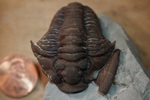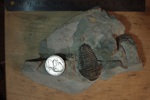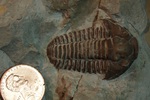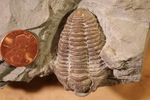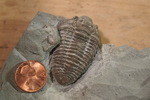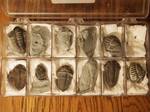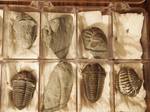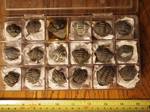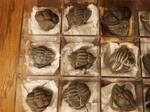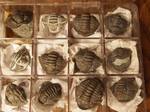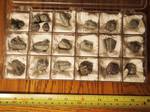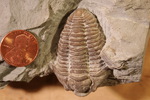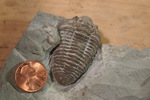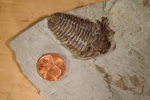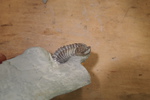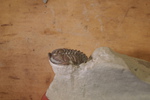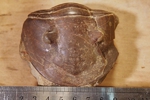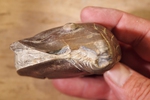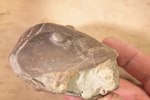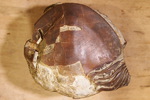
Photo Gallery
These are trilobites mined from the blue gray shale layer at Bushelman's quarry in Sharonville, Ohio during 1979 through 1981. The two foot shale unit was underlaid and overlain by brown shales within the exposure, and there were a number of fossiliferous horizons in the units below as well as above with regard to trilobites, which were normally Flexicalymene meeki with rare occurrences of Isotelus maximus. The outcrop featured a slope below the Corryville member of the McMillan formation with blue gray limestones exposed containing Rafinesquina and Platystrophia brachiopods which probably equated to the Bellevue formation. The quarry road led up the slope to where the Corryville member was exposed, and the surface of the upper portion of the quarry featured the beginning of distinctive brown clay and shale layers intercalated with minor thin blue limestones and clays. It was assumed that this marked the base of the Corryville member by me, and the remaining portion of the outcrop at the top consisted of over 30 feet of strata within the Corryville member of the McMillan formation of the Maysville Group from the Upper Ordovician Cincinnatian Series. Within the bottom layers of the Corryvillle member here Flexicalymene meeki and Isotelus maximus trilobites were found below the quarried unit within more than one horizon.
Perhaps 6 to 10 feet above the base was an unusual bryozoa layer containing Heterotrypa and Monticulopora colonies within a distinct horizon. Above this layer began the brown shales which contained the two foot thick blue gray shale unit from which the Flexicalymene meeki trilobites shown here were mined. The base of the shale was about five feet above the bryozoa horizon and it had an expanse of about 80 feet across the outcrop, lensing abruptly on each side into the brown shales over a distance of just a few feet. I interpreted the blue gray shale to be a channel consisting of an upper and lower horizon separated by a thin micritic layer of less than an inch in thickness which also occasionally contained trilobites. In one instance there was a cluster of seven individuals, one a bit larger than the others, the only cluster ever observed and they were all prone and right side up. The two thick blue gray shale units were fairly homogenous with regard to bedding and the trilobites were found somewhat randomly within it. Prone trilobites were more often found upside down in orientation and enrolled trilobites featured many variations in enrollment, most due to transport evidently.
In situ observations of two or three baby Flexicalymene meeki trilobites together on different occasions indicates that this was area was a breeding ground for these trilobites. A protected channel would seem like a good location for that if that was the case. Of special notice are the occasions where intact genal spines occur on the adult Flexicalymene meeki trilobites from this channel. Generally, I have inferred that they were preserved due to the lack of wave action which would have broken them. It appears that the broken spine attachment point is present in trilobites from other localities, such as Stonelick Creek, however no Flexicalymene meeki trilobites are ever found with the genal spines intact at these other localities. I have considered that they were just broken with time within their environment if it was not protected. The spines on the small Isotelus maximus trilobite shown within this gallery are equally impressive for their completeness. I do not know of any other locality that features Flexicalymene meeki trilobites with genal spines.
Unfortunately, this locality has been buried beneath fill and is currently destroyed. The blue gray shale layer continues into the hill beneath with about ten feet of overburden at the cut with another 20 feet or so of hillside above which would have been undercut had the excavation gone further. I was aided by an operator with a front loader or backhoe during which the removal of the majority of the overburden above the layer was completed. This was done four or five times over the course of the excavation. The beginning work was done by hand during the finding of the trilobite zone and some photos were taken during that time.
